

Lyrical Abstraction. Lyrical abstraction is either of two related but distinctly separate trends in Post-war Modernist painting, and a third definition is the usage as a descriptive term.
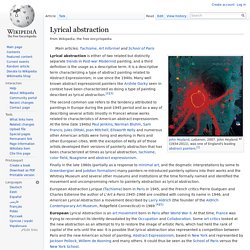
It is a descriptive term characterizing a type of abstract painting related to Abstract Expressionism; in use since the 1940s. Many well known abstract expressionist painters like Arshile Gorky seen in context have been characterized as doing a type of painting described as lyrical abstraction.[2][3] European Abstraction Lyrique (Tachisme) born in Paris in 1945, and the French critics Pierre Guéguen and Charles Estienne the author of L'Art à Paris 1945–1966 are credited with coining its name in 1946, and American Lyrical Abstraction a movement described by Larry Aldrich (the founder of the Aldrich Contemporary Art Museum, Ridgefield Connecticut) in 1969 [4][5] Lyrical abstraction was opposed not only to Cubist and Surrealist movements that preceded it, but also to geometric abstraction (or "cold abstraction"). Robert Rauschenberg. Robert Rauschenberg (October 22, 1925 – May 12, 2008) was an American painter and graphic artist whose early works anticipated the pop art movement.

Rauschenberg is well known for his "Combines" of the 1950s, in which non-traditional materials and objects were employed in innovative combinations. Rauschenberg was both a painter and a sculptor and the Combines are a combination of both, but he also worked with photography, printmaking, papermaking, and performance.[1][2] He was awarded the National Medal of Arts in 1993.[3] He became the recipient of the Leonardo da Vinci World Award of Arts in 1995 in recognition of his more than 40 years of fruitful artmaking.[4] Rauschenberg lived and worked in New York City as well as on Captiva Island, Florida until his death from heart failure on May 12, 2008.[5]
Tachisme. After World War II the term School of Paris often referred to Tachisme, the European equivalent of American abstract expressionism.

Important proponents were Jean-Paul Riopelle, Wols, Jean Dubuffet, Pierre Soulages, Nicolas de Staël, Hans Hartung, Serge Poliakoff, Georges Mathieu and Jean Messagier, among several others. (See list of artists below.) According to Chilvers, the term tachisme "was first used in this sense in about 1951 (the French critics Charles Estienne and Pierre Guéguen have each been credited with coining it) and it was given wide currency by [French critic and painter] Michel Tapié in his book Un Art autre (1952). " Pierre Soulages. Jean Dubuffet. Jean Philippe Arthur Dubuffet (31 July 1901 – 12 May 1985) was a French painter and sculptor.

His idealistic approach to aesthetics embraced so called "low art" and eschewed traditional standards of beauty in favor of what he believed to be a more authentic and humanistic approach to image-making. Life and work[edit] Dubuffet was born in Le Havre to a family of wholesale wine merchants who were part of the wealthy bourgeoisie.[1] He moved to Paris in 1918 to study painting at the Académie Julian, becoming close friends with the artists Juan Gris, André Masson, and Fernand Léger.
Six months later, he left the Académie to study independently. Art brut. Art brut est le terme par lequel le peintre Jean Dubuffet désigne les productions de personnes exemptes de culture artistique.

Il a regroupé certaines de ces productions au sein d'une collection, la Collection de l'art brut à Lausanne. S'il est certain que le terme art brut vient de Jean Dubuffet : « le 28 août 1945, Dubuffet baptise « art brut » un art qu'il collectionne depuis plusieurs années, art qui comprend à la fois l'art des fous et celui de marginaux de toutes sortes : prisonniers, reclus, mystiques, anarchistes ou révoltés[1], » on ne peut pas réduire son intérêt pour l'art des fous à cette seule date.
Bien avant, dès 1922, Dubuffet s'intéressait déjà aux travaux du docteur Hans Prinzhorn qui avait rassemblé les œuvres de malades mentaux, constituant un Musée d'art pathologique à Heidelberg. Color Field. Color Field painting is a style of abstract painting that emerged in New York City during the 1940s and 1950s.
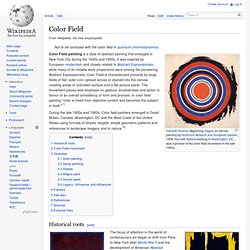
It was inspired by European modernism and closely related to Abstract Expressionism, while many of its notable early proponents were among the pioneering Abstract Expressionists. Color Field is characterized primarily by large fields of flat, solid color spread across or stained into the canvas creating areas of unbroken surface and a flat picture plane. The movement places less emphasis on gesture, brushstrokes and action in favour of an overall consistency of form and process. In color field painting "color is freed from objective context and becomes the subject in itself. Mark Rothko. Mark Rothko (Latvian: Markus Rotkovičs, Russian: Марк Ро́тко; born Ма́ркус Я́ковлевич Ротко́вич; Marcus Yakovlevich Rothkowitz; September 25, 1903 – February 25, 1970) was an American painter of Russian Jewish descent.
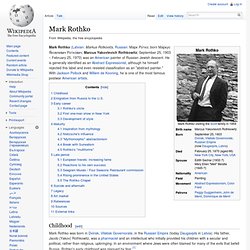
Victor Pasmore. Edwin John Victor Pasmore (3 December 1908 – 23 January 1998) was a British artist and architect.
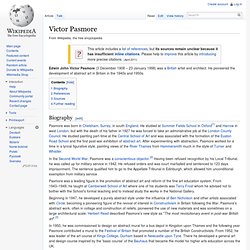
He pioneered the development of abstract art in Britain in the 1940s and 1950s. Adolph Gottlieb. Adolph Gottlieb (March 14, 1903 – March 4, 1974) was an American abstract expressionist painter, sculptor and printmaker.
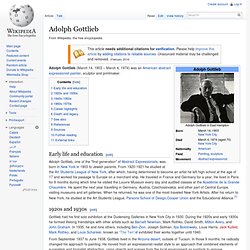
Early life and education[edit] Adolph Gottlieb, one of the "first generation" of Abstract Expressionists, was born in New York in 1903 to Jewish parents. From 1920-1921 he studied at the Art Students League of New York, after which, having determined to become an artist he left high school at the age of 17 and worked his passage to Europe on a merchant ship. He traveled in France and Germany for a year. He lived in Paris for 6 months during which time he visited the Louvre Museum every day and audited classes at the Académie de la Grande Chaumière. Barnett Newman. Robert Motherwell. Robert Motherwell (January 24, 1915 – July 16, 1991) was an American painter, printmaker, and editor.

Clyfford Still. Clyfford Still (November 30, 1904 – June 23, 1980) was an American painter, and one of the leading figures of Abstract Expressionism. Biography[edit] Clyfford Still was a leader in the first generation of Abstract Expressionists who developed a new, powerful approach to painting in the years immediately following World War II. Action painting. Action painting, sometimes called "gestural abstraction", is a style of painting in which paint is spontaneously dribbled, splashed or smeared onto the canvas, rather than being carefully applied.[1] The resulting work often emphasizes the physical act of painting itself as an essential aspect of the finished work or concern of its artist. Background[edit] The style was widespread from the 1940s until the early 1960s, and is closely associated with abstract expressionism (some critics have used the terms "action painting" and "abstract expressionism" interchangeably).
A comparison is often drawn between the American action painting and the French tachisme. The term was coined by the American critic Harold Rosenberg in 1952,[2] in his essay "The American Action Painters",[3] and signaled a major shift in the aesthetic perspective of New York School painters and critics. According to Rosenberg the canvas was "an arena in which to act". Jackson Pollock. Un article de Wikipédia, l'encyclopédie libre. Pour les articles homonymes, voir Pollock. Jackson Pollock Signature de Jackson Pollock Œuvres réputées Jackson Pollock a réalisé plus de 700 œuvres, peintures achevées, essais peints ou sculptés et dessins ainsi que quelques gravures.
En 1945, Pollock épousa l'artiste peintre Lee Krasner qui a eu une influence décisive sur sa carrière et sur la valorisation de son œuvre. Biographie[modifier | modifier le code] 1912-1937[modifier | modifier le code] Jackson Pollock naît dans l'Ouest américain. Mark Tobey. Early years[edit] Tobey was the youngest of four children in the Congregationalist family. Franz Kline. Tableaux de Jackson Pollock. Number 1 - Lavender Mist (1950)Huile, émail et peinture alu sur toile (221 x 299) Willem de Kooning. Willem de Kooning (April 24, 1904 – March 19, 1997) was a Dutch American abstract expressionist artist who was born in Rotterdam, the Netherlands.
In the post-World War II era, de Kooning painted in a style that came to be referred to as Abstract expressionism or Action painting, and was part of a group of artists that came to be known as the New York School. Other painters in this group included Jackson Pollock, Elaine de Kooning, Lee Krasner, Franz Kline, Arshile Gorky, Mark Rothko, Hans Hofmann, Adolph Gottlieb, Anne Ryan, Robert Motherwell, Philip Guston, and Clyfford Still.
In September 2011 de Kooning's work was honored with a large-scale retrospective exhibition: de Kooning: A Retrospective September 18, 2011 – January 9, 2012 at MoMA in New York City. Organized by John Elderfield it was the first major museum exhibition devoted to the full breadth and depth of de Kooning's career, containing nearly 200 works. Biography[edit] Mature works[edit] Arshile Gorky. Armenian-American painter. Tableaux de Willem De Kooning. Abstract expressionism. Style[edit] Technically, an important predecessor is surrealism, with its emphasis on spontaneous, automatic or subconscious creation. Jackson Pollock's dripping paint onto a canvas laid on the floor is a technique that has its roots in the work of André Masson, Max Ernst and David Alfaro Siqueiros.